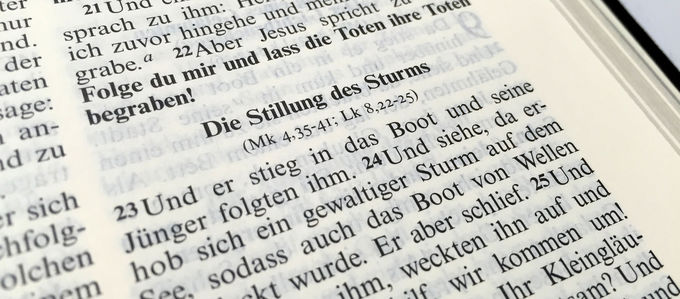
The revision of the German-language Bible translation by Martin Luther is nearly complete. Approximately 15,000 revisions were made in the Old and New Testaments; and yet the familiar character of the Bible is to be retained. nac.today provides some insight into the changes.
“Weeping and gnashing of teeth”—one of Luther’s well-known creations and something that is used in the German language to this day—is here to stay, also in the upcoming edition. Thank goodness. After all, many believe that the German language Bible by Martin Luther is the quintessence of powerful language. Of course there are many everyday terms in the Bible, but you also come across many expressions that make this translation so special and sacred. This ability is only one of the many things that speaks for Luther’s genius and the impact he had on the German language.
Martin Luther, a linguistic innovator
The religious reformer Martin Luther (1483–1546) began with his translation of the Bible into German in 1521. He had found refuge at Wartburg Castle, where he initially started work on the New Testament. The first edition was published in September 1522 (hence its name “September Testament”). Already in December of that same year, a second revised edition appeared. In the ensuing years, he worked on the Old Testament and translated it step by step and published it. In 1534 the first complete edition of the Luther Bible was published.
Already before and also after Martin Luther there were many more translations of the Bible. But the special quality, the mastery of Luther and his helpers was to watch and listen to the people and write in the vernacular of the day. They managed to create a translation that not only appealed to the readers and hearers, but also contributed to the standardization of the German language.
Binding for the New Apostolic Church
In the New Apostolic congregations worldwide, and the various languages, there are a number of officially binding Bible editions that are in use that have been authorized for use by the Church for divine service and liturgical texts. “The German language Bible by Martin Luther is considered very influential and significant,” Evangelist Reinhard Kiefer says, “the theological consultant of the Chief Apostle.”
And it always has been. “As far as I know, this was already the case at the time of the Catholic Apostolic Church. This surely goes back to the fact that this translation of the Bible is closely connected to the Reformation as it was advocated by Luther.” Other German Bible translations never achieved quite the same influence and authority as the one by Luther, “Even though Bruns, Albrecht, and others were used.”
Why are revisions necessary?
Already during his lifetime, Luther himself edited and revised his translation several times—right until his death in the year 1545. No one dared to touch his last revised edition of 1545 for a long time—called Letzter Hand (which implies “last edition authorized by the original author”)—until some 500 years later, when the colloquial language in Germany had evolved to such an extent that a revision had become essential. By this time there was also a great deal of new scientific evidence that had come to light about Greek and Hebrew, the original languages of the Bible. And old manuscripts had been discovered as well. There were three major revisions: in 1892, 1912, and in 1984.
Now there will be another revision. There will not be any drastic changes of the 1984 edition, the last revision. The corrections will be minor, mostly things that will only be noticed on second reading. The story of the calming of the storm in Matthew 8: 23–37 will, for example, no longer speak about a “storm” but about a “seaquake”, because the term seismos is used in the original Greek.
Five hundred years since the Reformation
The newly revised Luther Bible will be published just in time for the 500th anniversary of the Reformation in 2017. The result of the review will be presented to the chairman of the Protestant Church in Germany on 16 September 2015. Then it will be passed to the German Bible Society, which is responsible for its publication. There are plans to give the Bible a new look and a new face: a new font is being considered. Publication is expected by October 2016—just in time for the Reformation celebrations.
Until the year 2001, the New Apostolic congregations in the German-speaking areas used the 1912 edition. Currently, the 1984 edition is in use. Whether the new revision will move into the New Apostolic Church as official Bible in the German-speaking areas is something that will have to be seen, Evangelist Kiefer says, “We will have to review the 2017 revision in order to be able to assess whether the 1984 version should be replaced. No decisions whatsoever have been taken in this direction.”




